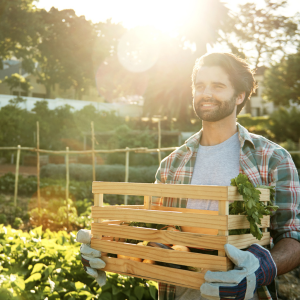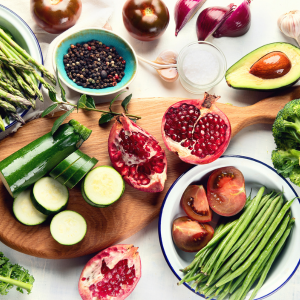In the modern restaurant industry, a refreshing trend is taking root: restaurants growing their own food. This engaging, sustainable, and innovative approach transforms how establishments source their ingredients and shape their menus.
This practice breathes a new life into the popular concept of farm-to-table dining, making it a crucial step further. Locally sourced ingredients have always been synonymous with freshness, quality, and sustainability, aligning perfectly with the core values of many contemporary consumers. By cultivating their own gardens, restaurants can tighten their control over the supply chain, ensuring the utmost quality of their produce and reducing their carbon footprint. Besides, there's no better way to guarantee the freshness of ingredients than harvesting them right outside your kitchen!
This in-depth blog aims to guide restaurants that wish to embark on this green venture. We will provide actionable steps to establish your own garden, from understanding local climate and soil, choosing the right seeds, and harvesting to integrating your grown produce into your menu. Taking the farm-to-table concept literally, we wish to help restaurants create a culinary experience that is not just appetizing but also wholesome and sustainable.
The Benefits Of Growing Your Own Food

Undoubtedly, one of the most salient benefits of restaurants growing their own food is the availability of fresher and higher-quality ingredients. Having your own garden allows for crop selection based on your cuisine, ensuring that the food you serve is as fresh and flavorful as it gets.
The move towards self-farming significantly reduces the carbon footprint. By eliminating or minimizing reliance on externally sourced ingredients, restaurants can reduce transportation costs and associated emissions, contributing positively to the environment.
Moreover, growing your own food builds an enhanced connection with the local community. Customers appreciate and value the transparency and authenticity offered by restaurants that grow their own food, often leading to increased patronage and stronger community bonding.
Lastly, it provides a unique opportunity to design unique menu offerings. Custom growing your ingredients allows you to experiment with heirloom varietals and hybrids, leading to novel, appealing dishes that set you apart from the competition.
Planning Your Food Garden
Strategic planning is the key to a successful restaurant garden. Start by identifying the types of crops compatible with your local climate and the particular growing conditions of your chosen site.
An understanding of crop rotation – growing different crops in succession on the same land – helps in maintaining soil fertility and in the management of pests and diseases. Additionally, take into account the principles of companion planting, where certain plants are grown together for their mutual benefit.
Lastly, don't limit yourself to the horizontal plane when planning your garden. Utilizing vertical space for crops like tomatoes, beans, and cucumbers can dramatically increase your yield without demanding extra square footage.
In conclusion, the venture of growing your own food requires meticulous planning and commitment, but its bounty in terms of quality, sustainability, and customer engagement makes it a worthwhile pursuit.
Sustainable Gardening Practices

As restaurants cultivate their own food gardens, prioritizing sustainable and eco-friendly gardening practices should be a cornerstone of their approach. These practices not only help preserve the environment but also contribute to the garden's longer-term productivity.
Composting is a vital practice that involves recycling organic waste into nutrient-rich matter, nourishing the soil, and providing essential nutrients to plants. Restaurant kitchens can significantly benefit from this method by recycling kitchen scraps to produce high-quality compost.
Mulching is another technique to consider. It helps retain soil moisture, regulate temperature, and suppress weeds, improving the overall health of the garden.
Additionally, implementing Integrated Pest Management (IPM) practices, which combine biological, cultural, and chemical methods for managing pests, can help reduce the use of synthetic pesticides and maintain the garden's ecological balance.
Emphasize the use of organic and natural fertilizers to maintain soil health and reduce the dependence on chemical inputs. Healthy soil is instrumental in improving the quality and productivity of your garden.
Staff Training And Involvement

Involving your restaurant staff in the garden's purpose and maintenance is crucial for success. Educate them on the significance of your food garden and how it impacts the environment, ingredient quality, and customer experience.
Develop a training program covering basic gardening tasks, such as planting, watering, and harvesting. This not only enhances their connection to the ingredients but also fosters a sense of ownership and pride in their work. Additionally, the gardening process can become a stress-relieving and team-building activity for the staff.
Menu Creation And Seasonal Ingredients

A restaurant garden dramatically influences menu creation and culinary creativity. Chefs now have the opportunity to curate recipes around seasonal ingredients harvested straight from the garden.
Planning menus around seasonal ingredients ensures optimal freshness, flavor, and sustainability. It also offers an educational platform to highlight the stories of homegrown produce, allowing customers to form a deeper connection to their meals.
For instance, a chef can showcase freshly harvested heirloom tomatoes in a vibrant summer salad or incorporate tender spring greens into an exquisite pasta dish. The possibilities are limited only by culinary imagination and the seasonal cycles of your garden.
By embracing the opportunities offered by a restaurant garden, chefs can create remarkable, memorable, and sustainable dining experiences that not only please palates but also nourish the relationship between the restaurant, its customers, and the environment.
Showcasing The Garden To Customers
When it comes to restaurant gardens, don't keep the marvel hidden. Showcasing your garden to customers can elevate their dining experience, making it interactive and immersive.
Consider offering garden tours to guests, allowing them to see where their food comes from and appreciate the hard work that goes into maintaining it. If feasible, allow guests to participate in the garden, such as picking their own herbs for a salad or cocktail.
Moreover, share the garden's story and sourcing practices on your menu, website, and social media. This transparency can help build trust and pique customer interest, leading to more loyal, engaged diners.
Community Engagement And Collaboration
The restaurant garden also proves a valuable avenue for community engagement and collaboration. Inviting the community to participate in garden events or workshops can help solidify your connection with the local citizenry and highlight your restaurant's commitment to locally sourced, sustainable cuisine.
Consider collaborating with schools, local farmers, and community organizations. Educational programs about gardening, food sourcing, and nutrition could be arranged in partnership with schools. Such initiatives not only foster a stronger sense of community but also promote awareness about sustainable food practices.
Tracking And Measuring Success
As you embark on your restaurant garden journey, remember to track its success and assess its impact on your operation. This involves measuring tangible factors such as savings from reduced ingredient costs and transportation expenses.
Assessing the garden's influence goes beyond monetary gains. Look for increases in customer foot traffic, enhanced customer loyalty, and interest in your garden-infused menu.
Capturing customer feedback is another crucial metric for success. Leverage reviews, surveys, and social media engagement to gauge the public's response to your garden-to-table initiative.
In conclusion, creating your own restaurant garden is a multi-faceted endeavor that offers a myriad of benefits. From sourcing fresh, locally grown produce and fostering staff pride to actively involving customers and the local community, the advantages span the environmental, economic, and social spheres. Embrace this step towards sustainability, and watch your restaurant bloom into an epicenter of culinary creativity and community engagement.
Overcoming Challenges: Growing Your Own Food
Growing your own food is indeed a rewarding endeavor, especially for restaurants aiming at fresher produce and sustainable practices. However, it can present a series of complexities, with weather variability and maintenance demands being at the top. Below are practical methods to overcome these challenges and thrive in your farming initiatives:
Regularly Monitor Weather Forecasts
The weather plays a significant role in the success of your crops. Regularly monitor local weather forecasts and regional climate trends. This enables you to anticipate challenges like sudden temperature changes, drought, or excessive rain. With this knowledge, you can modify your planting, watering, and harvesting schedules accordingly and potentially mitigate the adverse impacts.
Create Contingency Plans
While monitoring and preparation help, it's equally necessary to create contingency plans. These can range from simple protective measures like mulching to keep the soil temperature stable to more complex solutions like installing greenhouse coverings or irrigation systems to shield crops from extreme conditions. These contingency plans will help manage unexpected weather incidences or equipment breakdowns without drastically affecting your yield.
Reframe Failures As Learning Opportunities
Every obstacle you encounter in farming is a chance to learn and improve. The complexity of growing your own food means that occasionally, despite your best efforts, things may not go as planned. Instead of seeing these failures as setbacks, viewing them as stepping stones toward better practices can be more helpful. Here's how:
- Document Your Failures: This will help you understand what worked and what didn't. Take notes on specific challenges, what you attempted to fix them, and the results. This process will enable you to track patterns and identify areas for improvement.
- Identify Lessons Learned: Reflect on each failure to identify the lessons learned. How could you prevent or better handle a similar situation in the future?
- Update Your Practices: Based on your lessons learned, refine your farming practices. Continuous learning and improvements are essential for successful farming.
When viewed in such a light, every failure can turn into a future opportunity, leading to better, more productive farming practices.
Scaling Up And Expansion: Maximizing Restaurant Gardens
The thriving state of your restaurant garden is an excellent opportunity to scale up and expand. By doing so, you improve your restaurant's sustainability, enrich your cuisine, lower costs in the long term, and appeal to an increasingly environmentally-conscious customer base.
Here's how you could explore this opportunity:
Expanding The Current Garden Area
Expanding the current garden can be the most straightforward option if you have extra land available. More garden space allows for the following:
- More Variety: Grow a more diverse range of fruits, vegetables, and herbs, aligning this with the changing seasons and your evolving menu needs.
- Increased Quantity: Increase your garden's yield, reducing dependence on external suppliers and cutting costs over time.
- Multi-cropping: Implement strategies to maximize production in a smaller area and build a more resilient farm ecosystem.
Utilizing Available Rooftop Space
If land space is limited, consider extending your garden upward. Rooftop gardens not only make use of underutilized spaces and add aesthetic value but also:
- Reduce Energy Costs: Rooftop gardens provide a natural heat insulator, which can reduce heating and cooling costs.
- Improve Air Quality: Green roofs act as a filter for urban air, reducing pollution.
- Support Local Wildlife: They can help attract and provide habitats for beneficial insects and birds.
Ensure you undertake a structural assessment of the roof before you begin to ensure it can support the garden's weight.
Collaborating With Nearby Farms
Collaborating with nearby farms creates an avenue for extensive and diverse crop selection. This positive interaction encourages sharing knowledge on best practices, pest management, and crop rotation strategies. Moreover, partnering up with larger farms can assist in growing a wider array of crops that were initially too resource-intensive for a smaller garden. This partnership not only supports the local economy by backing local farmers but furthermore, it stimulates the creation of a more resilient food system. In addition, purchasing in bulk from local farms may also prove to be more cost-effective than individual produce growth. Therefore, these strategies allow restaurants to utilize the success of their garden to its highest potential, harmonizing the best aspects of nature, nutrient-rich ingredients, and sustainable practices.
In terms of benefits, growing your own food promotes ecological sustainability and culinary innovation. By implementing the key steps outlined in the guide, such as incorporating sustainable gardening practices and critical considerations like staff involvement, restaurants can successfully develop their own food gardens. With the assurance of overcoming challenges, scaling up, and community engagement, an eco-conscious garden holds the potential to transform a restaurant's operations, cuisine, and identity fundamentally.








